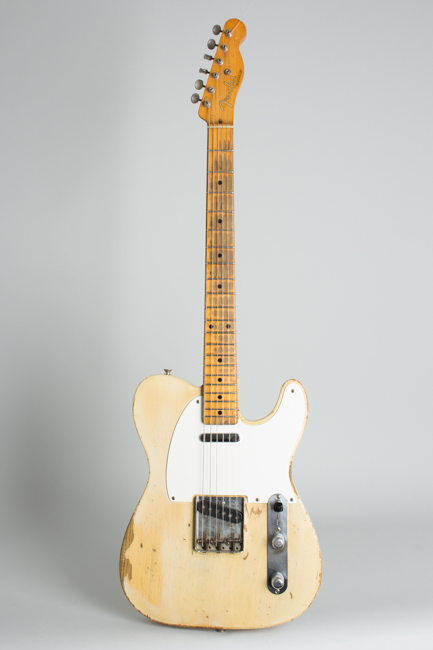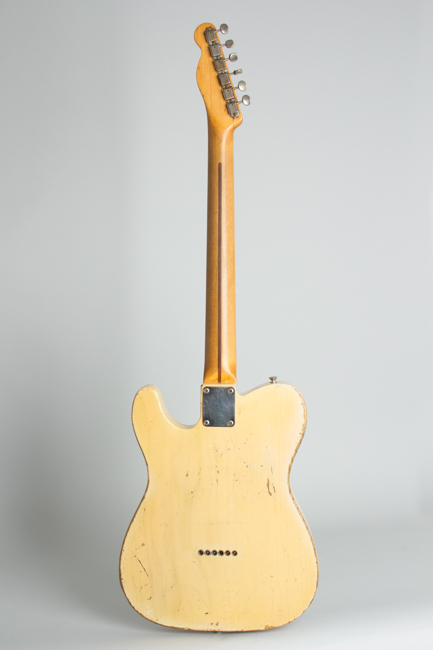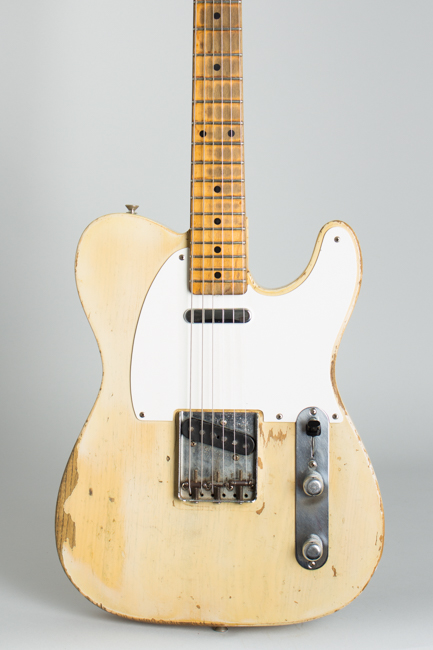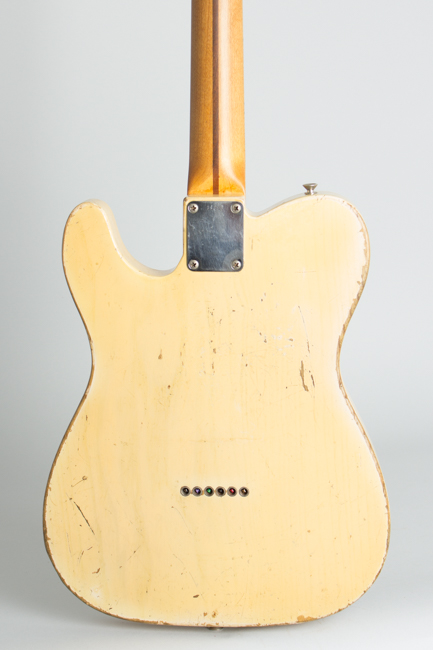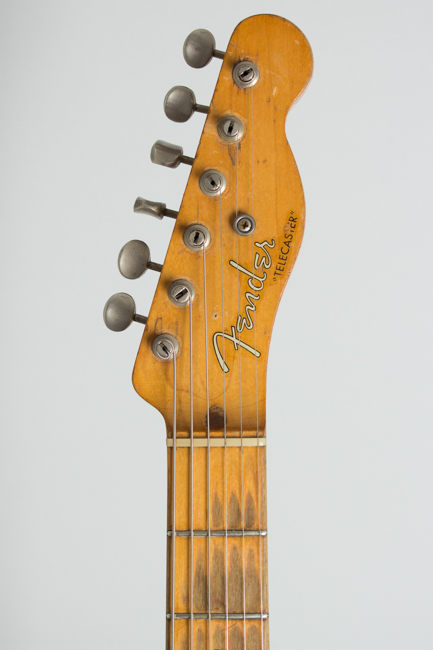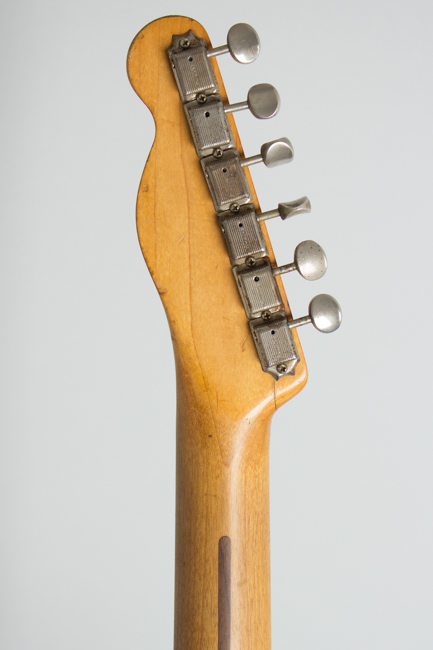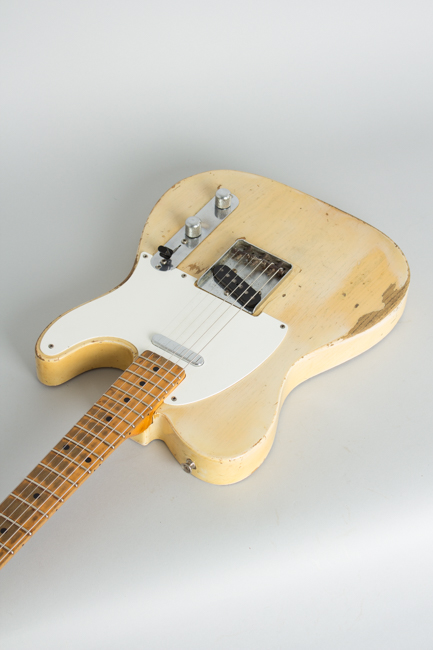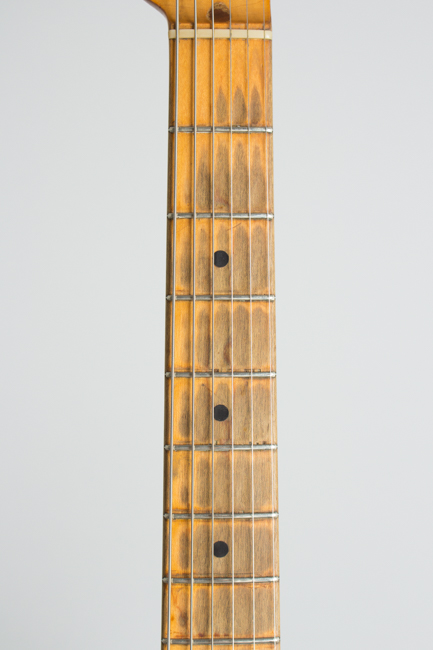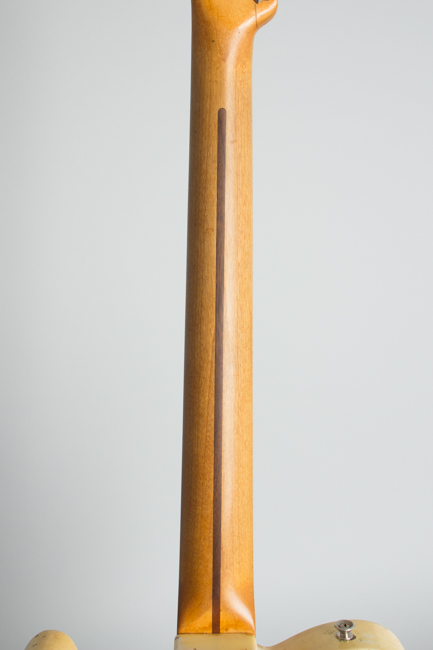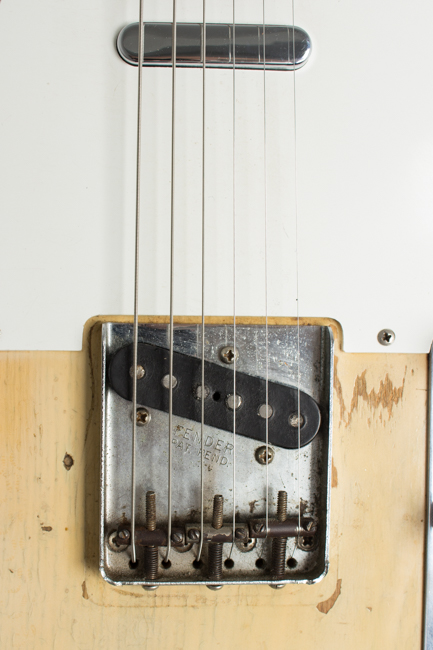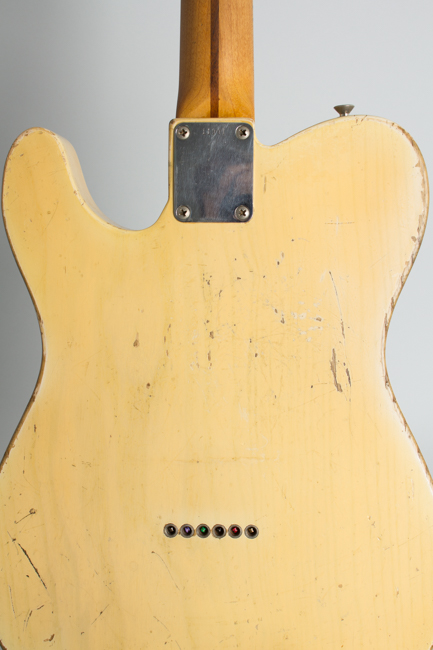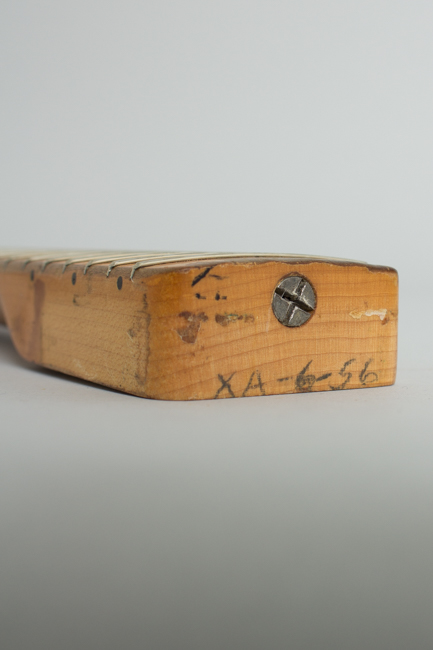Fender Telecaster Solid Body Electric Guitar (1956)
This item has been sold.
Item # 8774
Prices subject to change without notice.
Fender Telecaster Model Solid Body Electric Guitar (1956), made in Fullerton, California, Blonde lacquer finish, ash body, maple neck, tweed hard shell case.
This well-played early "whiteguard" 1956 Telecaster guitar shows characteristic features specific to this period in Tele history. The most immediately noticeable is the then-new single-ply white plastic pickguard which had recently replaced the earlier black phenolic piece on Teles and Precision Basses, making the look and production materials consistent with the then-new Stratocaster.
On the headstock the old script Fender "Telecaster" logo decal still sits below the original style round string tree, both unchanged from 1951. The nicely-grained ash body has a much lighter and "whiter" blonde finish compared to the darker earlier '50s-style butterscotch hue. This "white-blonde" look would be the norm in the late '50s, continuing up into the CBS era.
The one-piece maple neck is dated 6-56 and initialed "XA" (apparently by for Xavier, who initialed a lot of '56 necks) at the heel. The back of the neck has a medium-soft "V" contour, with less shoulder than earlier necks but not the sharp spine to come in 1957. The body is dated 6-56 in the lead pickup cavity, although enough lacquer has pooled in the rout to obscure this somewhat. The pots are dated are the 20th and 45th weeks of 1956.
The staggered-pole lead pickup is the earliest version of this newer design, generally similar to earlier Telecaster units but with the altered magnet layout with the center poles raised slightly. This guitar's wiring has been altered to "modern" spec with the original "mud cap" removed and the center switch position enabling a blend of both pickups. The original wiring and control parts are still intact; only the solder joints pertaining to this common alteration have been re-done. The serial number is stamped on the neck plate having just been moved there from the bridge tray when Fender harmonized all their electric guitars into one number series in 1955. The knobs are a smoother-sided knurl with a dome top and the switch tip is the new "top hat" style recently introduced.
This 1956 Telecaster has seen a lot of use and has a completely authentic "relic" look to it that is being widely and artificially reproduced today. It is also a fantastic-sounding guitar and a joy to play, with that genuine "worn-in Fender" feel that is very difficult to capture. By 1956 the Telecaster had become a success, renowned as a popular tool used by working musicians, including a host of early rock'n'roll and country players. Many have been played for decades and worn virtually into the ground; this one has its road scars but is still a truly great instrument and a genuine survivor.
Overall length is 38 3/4 in. (98.4 cm.), 12 5/8 in. (32.1 cm.) wide at lower bout, and 1 3/4 in. (4.4 cm.) in depth, measured at side of rim. Scale length is 25 1/2 in. (648 mm.). Width of nut is 1 5/8 in. (41 mm.).
This old Telecaster has had a lot of play time and some typical maintenance modifications over the years but remains an excellent-playing and sounding guitar. The original blonde lacquer finish is intact with a good deal of wear on all surfaces. It has also had some very light overspray to the top; this appears quite old and a significant portion has been rubbed away over time. This is only really noticeable under a blacklight examination.
The guitar is wired to "modern" spec, allowing the pickups to be easily blended, but the pickups and all the components of the wiring rig are still original -- only some solder joints have been re-done and the "bass cap" removed. The single-layer white plastic pickguard appears the correct style but is not original to the guitar; this is confirmed by a second mounting hold at the tip of the lower horn. All other body hardware including the control plate, knobs, and strap buttons appear original and unaltered. There is a light marking to the top finish around the back rear of the bridge from what looks to have been a non-standard snap-on cover, or some other mystery item.
The headstock has seen some work; the tuners have been restored back to the original Kluson Deluxes. Long ago (likely the 1970s) the holes were enlarged somewhat for Shaller Mini tuners, a common modification at the time. Related to this, there is a typical very small crack off the low E tuner mounting screw, not deep into the wood but visible. The headstock face shows old compression rings to the wood from the Schallers, a couple of small chips to the edges of the tuner holes (repaired with the original small pieces glued back in), and a small screw hole visible from a second string tree.
The back of the neck and fingerboard have significant wear down to the bare wood over much of its length; this guitar has been played a LOT. Unsurprisingly, it has been refretted with not overlarge wire; the job is visually not the neatest (there are tiny pulls to the maple fingerboard visible on the edges of some frets), but it actually plays very well.
The phrase "genuine relic" pretty much sums this one up. It's just one of those guitars you don't want to put down. Great-feeling and fantastic-sounding with a meatier lead tone than many mid-'50s Telecasters and some nicely transparent blended tones as well. Ready to go back out on the road, and housed in a good (likely 1980s) re-issue tweed case. Very Good + Condition.
This well-played early "whiteguard" 1956 Telecaster guitar shows characteristic features specific to this period in Tele history. The most immediately noticeable is the then-new single-ply white plastic pickguard which had recently replaced the earlier black phenolic piece on Teles and Precision Basses, making the look and production materials consistent with the then-new Stratocaster.
On the headstock the old script Fender "Telecaster" logo decal still sits below the original style round string tree, both unchanged from 1951. The nicely-grained ash body has a much lighter and "whiter" blonde finish compared to the darker earlier '50s-style butterscotch hue. This "white-blonde" look would be the norm in the late '50s, continuing up into the CBS era.
The one-piece maple neck is dated 6-56 and initialed "XA" (apparently by for Xavier, who initialed a lot of '56 necks) at the heel. The back of the neck has a medium-soft "V" contour, with less shoulder than earlier necks but not the sharp spine to come in 1957. The body is dated 6-56 in the lead pickup cavity, although enough lacquer has pooled in the rout to obscure this somewhat. The pots are dated are the 20th and 45th weeks of 1956.
The staggered-pole lead pickup is the earliest version of this newer design, generally similar to earlier Telecaster units but with the altered magnet layout with the center poles raised slightly. This guitar's wiring has been altered to "modern" spec with the original "mud cap" removed and the center switch position enabling a blend of both pickups. The original wiring and control parts are still intact; only the solder joints pertaining to this common alteration have been re-done. The serial number is stamped on the neck plate having just been moved there from the bridge tray when Fender harmonized all their electric guitars into one number series in 1955. The knobs are a smoother-sided knurl with a dome top and the switch tip is the new "top hat" style recently introduced.
This 1956 Telecaster has seen a lot of use and has a completely authentic "relic" look to it that is being widely and artificially reproduced today. It is also a fantastic-sounding guitar and a joy to play, with that genuine "worn-in Fender" feel that is very difficult to capture. By 1956 the Telecaster had become a success, renowned as a popular tool used by working musicians, including a host of early rock'n'roll and country players. Many have been played for decades and worn virtually into the ground; this one has its road scars but is still a truly great instrument and a genuine survivor.
Overall length is 38 3/4 in. (98.4 cm.), 12 5/8 in. (32.1 cm.) wide at lower bout, and 1 3/4 in. (4.4 cm.) in depth, measured at side of rim. Scale length is 25 1/2 in. (648 mm.). Width of nut is 1 5/8 in. (41 mm.).
This old Telecaster has had a lot of play time and some typical maintenance modifications over the years but remains an excellent-playing and sounding guitar. The original blonde lacquer finish is intact with a good deal of wear on all surfaces. It has also had some very light overspray to the top; this appears quite old and a significant portion has been rubbed away over time. This is only really noticeable under a blacklight examination.
The guitar is wired to "modern" spec, allowing the pickups to be easily blended, but the pickups and all the components of the wiring rig are still original -- only some solder joints have been re-done and the "bass cap" removed. The single-layer white plastic pickguard appears the correct style but is not original to the guitar; this is confirmed by a second mounting hold at the tip of the lower horn. All other body hardware including the control plate, knobs, and strap buttons appear original and unaltered. There is a light marking to the top finish around the back rear of the bridge from what looks to have been a non-standard snap-on cover, or some other mystery item.
The headstock has seen some work; the tuners have been restored back to the original Kluson Deluxes. Long ago (likely the 1970s) the holes were enlarged somewhat for Shaller Mini tuners, a common modification at the time. Related to this, there is a typical very small crack off the low E tuner mounting screw, not deep into the wood but visible. The headstock face shows old compression rings to the wood from the Schallers, a couple of small chips to the edges of the tuner holes (repaired with the original small pieces glued back in), and a small screw hole visible from a second string tree.
The back of the neck and fingerboard have significant wear down to the bare wood over much of its length; this guitar has been played a LOT. Unsurprisingly, it has been refretted with not overlarge wire; the job is visually not the neatest (there are tiny pulls to the maple fingerboard visible on the edges of some frets), but it actually plays very well.
The phrase "genuine relic" pretty much sums this one up. It's just one of those guitars you don't want to put down. Great-feeling and fantastic-sounding with a meatier lead tone than many mid-'50s Telecasters and some nicely transparent blended tones as well. Ready to go back out on the road, and housed in a good (likely 1980s) re-issue tweed case. Very Good + Condition.
